Abstract:
Multidisciplinary palaeolimnological approaches were applied to long sediment cores from Längsee, Carinthia. Climate amelioration after deglaciation allowed the expansion of shrubs and timber-line trees and the onset of plankton and probably lake summer stratification. This phase called Pre-Bölling has an upper boundary of approx. 16 kyrs BP. The change from a steppe to a tundra-like vegetation culminated during the following less temperate, humid phase, with lower in-lake productivity (Oldest Dryas, Ia; 16-13.6 kyrs BP). At about 13.6 kyrs BP when reforestation took place, summer surface water temperature increased towards recent temperatures and hypolimnetic anoxia developed. Different anoxic levels in respect to climate change underline the dynamic type of meromixis. Levels varied, being highest during the Preboreal/Boreal, and lowered during the Atlantic towards recent levels. The contrast between low trophic status and sediments enriched in organic matter characterizes "pseudeutrophic lake stratification" before the onset of human impact. Changes in the pelagic cladoceran communities during this time seem to be related to changes in predation. Aside long-term climatic change during the Atlantic, short-term fluctuations of precipitation within climate oscillations are suggested as possible causes of erosion processes, changes in lake level and water temperature. These are indicated for the Oldest and Younger Dryas, the Boreal/Atlantic and the Subboreal/Subatlantic transitions. They most likely act as the trigger mechanism for temporary mixing and changes in redox conditions. Extensive forest clearance in the catchment during Bronze-Age settlement caused a change in sediment type and temporary nutrient enrichment. The perturbations are comparable with erosion processes during the late-glacial when climate oscillations were the only driving forces. Anthropogenic influences on the lake environment vary according to land-use type.
Similar content being viewed by others
Author information
Authors and Affiliations
Additional information
Received 5 July 1996; revised manuscript accepted 17 March 1997.
Rights and permissions
About this article
Cite this article
Schmidt, R., Wunsam, S., Brosch, U. et al. Late and post-glacial history of meromictic Längsee (Austria), in respect to climate change and anthropogenic impact. Aquat. Sci. 60, 56–88 (1998). https://doi.org/10.1007/PL00001313
Issue Date:
DOI: https://doi.org/10.1007/PL00001313




